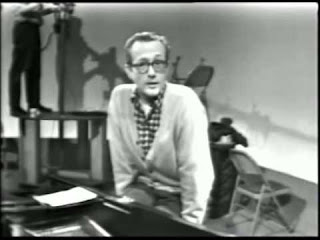Today (May 29) is his birthday.
 |
| Click Bob's image to see a short clip on his legacy to the world of comedy. |
After a short stint as a boxer ("I was called Rembrandt Hope in my boxing days, because I spent so much time on the canvas!") and after working the vaudeville circuit ("When vaudeville died, television was the box they put it in."), Bob Hope’s career took off with his appearance in The Big Broadcast of 1938. He and Shirley Ross were cast as a divorced couple who meet again on a transatlantic ocean liner and sift through the ashes of their marriage. The duet, “Thanks for the Memory,” has been called "one of the most beautifully written and performed musical numbers in all of movies.” This five-minute-plus piece of film gave him a career-long theme song and made him a star.
 |
| Click Shirley Ross and Bob Hope to see them performing what became his theme song, "Thanks for the Memory" from The Big Broadcast of 1938. |
 |
| Many early TV sketches played off of vaudeville routines. Click Jack Benny and Bob to see them playing it for laughs with a birthday cake Jack presents to Bob. Slapstick at its messiest! |
Bob had a staff of writers who helped him fill a vault of cataloged jokes throughout his career. He was known for relying on cue cards, and some critics considered the jokes to be the weakest part of his act. The strongest part was his crisp, I-dare-you-not-to-laugh delivery. He used this formula in a record number of appearances as an Oscar show host (nineteen, including his co-host stints - He frequently joked about never winning an Oscar: "Welcome to the Academy Awards, or as it's known at my house, Passover!"), his annual Christmas visitations with the troops (which would then be packaged as specials), and his guest appearances on other television programs with their own monologists, like Johnny Carson’s Tonight Show.
 |
| Click Bob in action to see an example of his delivery. |
Want more Hope? Here are some quotable quips:
A bank is a
place that will lend you money if you can prove you don't need it.
I do benefits
for all religions - I'd hate to blow the hereafter on a technicality.
I
always like to go to Washington D.C. It gives me a chance to visit my money.
The older you get, the tougher it is to
lose weight, because by then your body and your fat are really good friends.
I
don't do a lot of political jokes. Too many are getting elected.
I
love flying. I've been to almost as many places as my luggage.
Bigamy is the only crime where two rites
make a wrong.
A sense of humor is good for you. Have you
ever heard of a laughing hyena with heart burn?
Incredibly, this show is coming to you live, no matter how I may look to you in this suit!
Incredibly, this show is coming to you live, no matter how I may look to you in this suit!


















